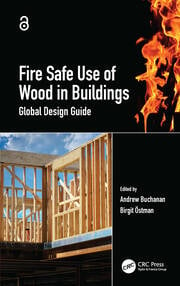ABSTRACT
The Open Access version of this book, available at https://www.taylorfrancis.com, has been made available under a Creative Commons [Attribution-Non Commercial-No Derivatives (CC-BY-NC-ND)] 4.0 license. Funded by Linneaus University.
It provides guidance on the design of timber buildings for fire safety, developed within the global network Fire Safe Use of Wood (FSUW) and with reference to Eurocode 5 and other international codes. It introduces the behaviour of fires in timber buildings and describes strategies for providing safety if unwanted fires occur. It provides guidance on building design to prevent any fires from spreading while maintaining the load-bearing capacity of structural timber elements, connections and compartmentation. Also included is information on the reaction-to-fire of wood products according to different classification systems, as well as active measures of fire protection, and quality of workmanship and inspection as means of fulfilling fire safety objectives.
- Presents global guidance on fire safety in timber buildings
- Provides a wide perspective, covering the whole field of fire safety design
- Uses the latest scientific knowledge, based on recent analytical and experimental research results
- Gives practical examples illustrating the importance of good detailing in building design
Fire Safe Use of Wood in Buildings is ideal for all involved in the fire safety of buildings, including architects, engineers, firefighters, educators, regulatory authorities, insurance companies and professionals in the building industry.


